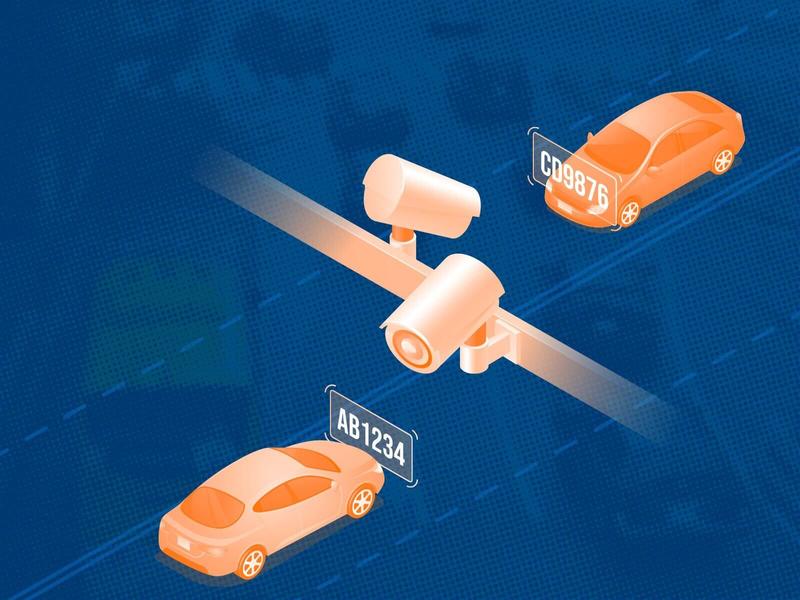With the growing advancements in artificial intelligence, automatic license plate recognition (also known as ANPR – Automatic Number Plate Recognition) has become incredibly reliable. From traffic monitoring to automatic tolling in parking lots or highway sections, these systems can help automatically monitor a significant number of license plates daily, enabling companies that need this type of tool to process a large number of plates simply and effectively. But in which application scenarios is it useful? And how reliable are these systems really? And how do they work? If you’re asking these questions, you’re in the right place!
How does automatic license plate recognition work?
At the core of automatic recognition systems is computer vision, a branch of artificial intelligence (AI) that enables machines to interpret and make decisions based on images and videos. To automatically recognize license plates, the AI analyzes images from cameras and for each vehicle reads the corresponding plate through a process called Optical Character Recognition (OCR). Thanks to this process, each character on the plate detected in the image is transcribed into text format. The information can then be saved in a database or displayed on software in real time.
These readings can also be combined with other automatic recognition tools such as, for example, vehicle type classification and tracking, nationality, or automatic speed estimation.
Advantages and challenges
With automatic license plate recognition, it’s possible to actively monitor a very large number of vehicles. Consider, for example, a highway section traveled by millions of vehicles every year. Manually processing these transits would be unthinkable due to the time and costs this process would entail. An automatic system can process images in the order of milliseconds, offering scalability and operational efficiency without equal, but that’s not all. In some contexts, it may not be necessary to monitor a large number of plates, and automation can still bring advantages, such as in automated parking lots, where a camera can autonomously monitor vehicle parking even in the absence of a dedicated operator.
Processing speed is not the only advantage of an automated system. In addition to speed, these systems must also be reliable. The question that may arise is therefore: how accurate are these systems? The answer to this question is not trivial. The system’s accuracy can indeed depend on various operational conditions, such as the quality of the cameras capturing the images, the frequency with which they do so, the distance, lighting conditions, and visibility, which in some cases may be compromised. The only way to answer this question precisely is to test the system in the field, under various weather and lighting conditions. Despite this, to give a qualitative answer, we can state that a sufficiently robust system will be able to maintain performance very close to human levels even in more difficult visibility conditions. To give you a concrete example, at Synapsi we developed and tested a transit recognition system for a client in the highway sector. Comparing the performance of an automatic system with human operators under poor visibility conditions, we found that the latter tended to make mistakes in almost 20% of the readings, while our system made mistakes in only 2.2% of the same sample.
Use cases
Automatic license plate recognition opens the door to multiple applications.
Parking management systems
Often, parking spaces need to be monitored automatically without having to install a parking meter. This is the case in many supermarkets or other commercial activities, where spaces reserved for customers are often abused and used as long-term parking. In such cases, surveillance cameras can also be repurposed to automatically charge a fee for stays exceeding a certain duration. Similarly, an automatic monitoring system allows for counting the number of parked vehicles and available parking spaces.
Verification of authorized access
License plate recognition also enables automatic verification of authorized access. Consider, for example, limited traffic zones (ZTL) or other restricted access areas. In such cases, a reliable automatic monitoring system can drastically reduce monitoring costs by automatically reporting violations.
Traffic monitoring and security
In smart cities, automatic license plate recognition systems allow for automatic monitoring of passing vehicles, analyzing traffic, speed in real time, or enabling authorities to quickly find suspicious vehicles. They are often used in free-flow highway sections for transit recognition or in municipalities for monitoring busier areas.
Claim management systems
In the insurance sector, automatic license plate recognition speeds up claims management processes. By combining automatic plate extraction with other vehicle information such as the VIN (Vehicle Identification Number), body components, miles traveled, and damages, processes can be accelerated, reducing management costs and ensuring faster service for clients.
Looking for a custom automatic license plate recognition solution?
At Synapsi, we have developed license plate recognition systems in various contexts, ranging from the insurance sector to highways, from prototyping to industrialization. We are well aware of the challenges and results that can be achieved and can assist you in developing and integrating these systems within other corporate systems. If you need our support, don’t hesitate to schedule a free consultation with our team!

